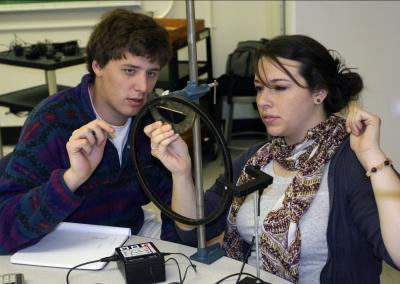Women consistently score lower than men on common assessments of conceptual understanding of physics but there is no clear reason why.
Controlling for student background and test-taking strategies provides little help and therefore claims that the causes of this gender gap have been determined (gender bias, stereotype threat) lack substance.
Education is an ongoing experiment. In recent decades, classrooms have tried to shift from a traditional lecture presentation to more interactive formats with the goal of students building their own knowledge.Physics has always led the way in new approaches, in part because there is a great deal of interest in optimizing how students can grapple with key ideas in this difficult field. Comparisons of student understanding have been made possible through the development of "concept inventories" – multiple choice tests of student understanding, developed through years of research, enabling the same test to be given to students in a variety of classrooms.
The authors of a recent overview paper combined results from 26 previous studies of several common physics concept inventories, covering 12 different institutions. They found that women almost always score lower than men on these tests (12% on average for tests about force and motion), both before instruction, and at the end of the course. The same trend is also found when comparing male and female students' gains on the tests, showing that this gap is not simply due to differing levels of incoming knowledge.

An interactive physics classroom, whose teaching techniques can improve student gains on tests by four times as much as the size of the gap between men's and women's scores. Credit: Thomas Cox, University of North Carolina at Chapel Hill
There is some variation across studies – the gender gap sometimes goes up and sometimes goes down, but rarely goes away, observe the authors. Women also receive lower scores on course exams (4% on average) than do men, which can impact course grades. These results mirror those in other studies of gender differences on other types of science and math tests, such as standardized placement exams.
One key finding from the study is that, while there is a gender gap in performance on concept inventories, the performance of both men and women is improved when they experience an interactive classroom. These teaching techniques improve student gains on these tests by four times as much as the size of the gap between men's and women's scores. Thus, previous results on the positive impact of interactive teaching techniques are still valid for both men and women.
Another important result of the authors' analysis is that no obvious factor appears to be responsible for women's lower scores. Unlike the impact of interactive engagement on student performance, "we haven't found a miracle that solves the gender gap," said co-author Dr. Sarah McKagan.
The authors cross-checked the results from studies claiming potential impact of student background, their beliefs about physics, the teaching method used, their ingrained stereotypes about women's abilities, and the wording of test questions.
Some studies – several of which were quite high-profile – claimed that one or more of these elements had a significant influence, but most were contradicted in other studies. Background preparation in physics may account for much of the gender gap but those results have not been replicated outside of a single university and may be reflective of several other underlying causes.
Such contradictory results suggest that gender differences in physics performance are a particularly thorny and complex issue. When a single study claims to have found a solution to gender differences in science, it should be treated with healthy skepticism. Research on female performance in math and science more broadly have also met with contradictory results, though social factors – such as stereotypes – are assumed to contribute to gender gaps. However, those claims are offset by the fact that 70% of high school teachers are women and, more recently, No Child Left Behind saw female students achieve parity with males on tests for the first time in history
So though the gender gap on physics concept inventories remains an unsolved problem, the researchers have a take-home message for instructors: Interactive teaching techniques can improve student understanding for both genders; and that there is a gender gap on conceptual assessments and exams will require creativity on the part of the instructor.
Prior work suggests some strategies that an instructor may take (such as having students reflect on their values prior to a test), but it is important not to rely too heavily on any one technique. The authors call for researchers to devote additional attention to investigating the underlying causes of this gender gap and possible interventions.
Citation: A. Madsen, S. B. McKagan and E. C. Sayre, 'The gender gap on concept inventories in physics: what is consistent, what is inconsistent, and what factors influence the gap?', upcoming in Physical Review Special Topics – Physics Education Research





Comments